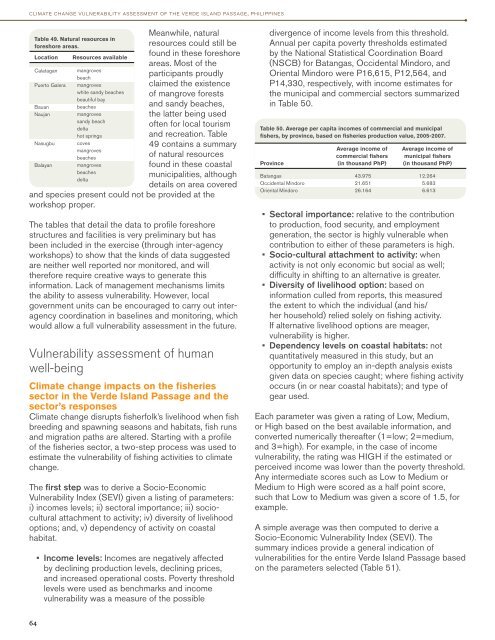of the Verde Island Passage, Philippines - weADAPT
of the Verde Island Passage, Philippines - weADAPT
of the Verde Island Passage, Philippines - weADAPT
You also want an ePaper? Increase the reach of your titles
YUMPU automatically turns print PDFs into web optimized ePapers that Google loves.
climate change vulnerability assessment <strong>of</strong> <strong>the</strong> verde island passage, philippines<br />
Table 49. Natural resources in<br />
foreshore areas.<br />
Location<br />
Calatagan<br />
Puerto Galera<br />
Bauan<br />
Naujan<br />
Nasugbu<br />
Balayan<br />
Resources available<br />
mangroves<br />
beach<br />
mangroves<br />
white sandy beaches<br />
beautiful bay<br />
beaches<br />
mangroves<br />
sandy beach<br />
delta<br />
hot springs<br />
coves<br />
mangroves<br />
beaches<br />
mangroves<br />
beaches<br />
delta<br />
Meanwhile, natural<br />
resources could still be<br />
found in <strong>the</strong>se foreshore<br />
areas. Most <strong>of</strong> <strong>the</strong><br />
participants proudly<br />
claimed <strong>the</strong> existence<br />
<strong>of</strong> mangrove forests<br />
and sandy beaches,<br />
<strong>the</strong> latter being used<br />
<strong>of</strong>ten for local tourism<br />
and recreation. Table<br />
49 contains a summary<br />
<strong>of</strong> natural resources<br />
found in <strong>the</strong>se coastal<br />
municipalities, although<br />
details on area covered<br />
and species present could not be provided at <strong>the</strong><br />
workshop proper.<br />
The tables that detail <strong>the</strong> data to pr<strong>of</strong>ile foreshore<br />
structures and facilities is very preliminary but has<br />
been included in <strong>the</strong> exercise (through inter-agency<br />
workshops) to show that <strong>the</strong> kinds <strong>of</strong> data suggested<br />
are nei<strong>the</strong>r well reported nor monitored, and will<br />
<strong>the</strong>refore require creative ways to generate this<br />
information. Lack <strong>of</strong> management mechanisms limits<br />
<strong>the</strong> ability to assess vulnerability. However, local<br />
government units can be encouraged to carry out interagency<br />
coordination in baselines and monitoring, which<br />
would allow a full vulnerability assessment in <strong>the</strong> future.<br />
Vulnerability assessment <strong>of</strong> human<br />
well-being<br />
Climate change impacts on <strong>the</strong> fisheries<br />
sector in <strong>the</strong> <strong>Verde</strong> <strong>Island</strong> <strong>Passage</strong> and <strong>the</strong><br />
sector’s responses<br />
Climate change disrupts fisherfolk’s livelihood when fish<br />
breeding and spawning seasons and habitats, fish runs<br />
and migration paths are altered. Starting with a pr<strong>of</strong>ile<br />
<strong>of</strong> <strong>the</strong> fisheries sector, a two-step process was used to<br />
estimate <strong>the</strong> vulnerability <strong>of</strong> fishing activities to climate<br />
change.<br />
The first step was to derive a Socio-Economic<br />
Vulnerability Index (SEVI) given a listing <strong>of</strong> parameters:<br />
i) incomes levels; ii) sectoral importance; iii) sociocultural<br />
attachment to activity; iv) diversity <strong>of</strong> livelihood<br />
options; and, v) dependency <strong>of</strong> activity on coastal<br />
habitat.<br />
• Income levels: Incomes are negatively affected<br />
by declining production levels, declining prices,<br />
and increased operational costs. Poverty threshold<br />
levels were used as benchmarks and income<br />
vulnerability was a measure <strong>of</strong> <strong>the</strong> possible<br />
divergence <strong>of</strong> income levels from this threshold.<br />
Annual per capita poverty thresholds estimated<br />
by <strong>the</strong> National Statistical Coordination Board<br />
(NSCB) for Batangas, Occidental Mindoro, and<br />
Oriental Mindoro were P16,615, P12,564, and<br />
P14,330, respectively, with income estimates for<br />
<strong>the</strong> municipal and commercial sectors summarized<br />
in Table 50.<br />
Table 50. Average per capita incomes <strong>of</strong> commercial and municipal<br />
fishers, by province, based on fisheries production value, 2005-2007.<br />
Average income <strong>of</strong> Average income <strong>of</strong><br />
commercial fishers municipal fishers<br />
Province (in thousand PhP) (in thousand PhP)<br />
Batangas<br />
Occidental Mindoro<br />
Oriental Mindoro<br />
43.975<br />
21.651<br />
26.164<br />
12.264<br />
5.683<br />
6.613<br />
• Sectoral importance: relative to <strong>the</strong> contribution<br />
to production, food security, and employment<br />
generation, <strong>the</strong> sector is highly vulnerable when<br />
contribution to ei<strong>the</strong>r <strong>of</strong> <strong>the</strong>se parameters is high.<br />
• Socio-cultural attachment to activity: when<br />
activity is not only economic but social as well;<br />
difficulty in shifting to an alternative is greater.<br />
• Diversity <strong>of</strong> livelihood option: based on<br />
information culled from reports, this measured<br />
<strong>the</strong> extent to which <strong>the</strong> individual (and his/<br />
her household) relied solely on fishing activity.<br />
If alternative livelihood options are meager,<br />
vulnerability is higher.<br />
• Dependency levels on coastal habitats: not<br />
quantitatively measured in this study, but an<br />
opportunity to employ an in-depth analysis exists<br />
given data on species caught; where fishing activity<br />
occurs (in or near coastal habitats); and type <strong>of</strong><br />
gear used.<br />
Each parameter was given a rating <strong>of</strong> Low, Medium,<br />
or High based on <strong>the</strong> best available information, and<br />
converted numerically <strong>the</strong>reafter (1=low; 2=medium,<br />
and 3=high). For example, in <strong>the</strong> case <strong>of</strong> income<br />
vulnerability, <strong>the</strong> rating was HIGH if <strong>the</strong> estimated or<br />
perceived income was lower than <strong>the</strong> poverty threshold.<br />
Any intermediate scores such as Low to Medium or<br />
Medium to High were scored as a half point score,<br />
such that Low to Medium was given a score <strong>of</strong> 1.5, for<br />
example.<br />
A simple average was <strong>the</strong>n computed to derive a<br />
Socio-Economic Vulnerability Index (SEVI). The<br />
summary indices provide a general indication <strong>of</strong><br />
vulnerabilities for <strong>the</strong> entire <strong>Verde</strong> <strong>Island</strong> <strong>Passage</strong> based<br />
on <strong>the</strong> parameters selected (Table 51).<br />
64
















